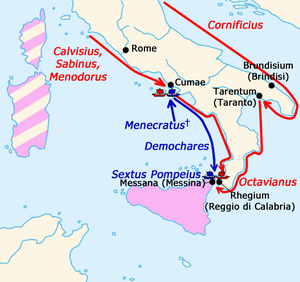Bellum Siculum
This article includes a list of general references, but it lacks sufficient corresponding inline citations. (September 2018) |
| Bellum Siculum | |||||||||
|---|---|---|---|---|---|---|---|---|---|
| Part of the Roman civil wars | |||||||||
 Coin of Sextus Pompey, minted in Sicily in 37 or 36 BC. | |||||||||
| |||||||||
| Belligerents | |||||||||
| Second Triumvirate |
Optimates | ||||||||
| Commanders and leaders | |||||||||
|
Titus Statilius Taurus Gaius Calvisius Sabinus Mark Antony Marcus Titius Gaius Furnius Amyntas of Galatia | |||||||||
| Casualties and losses | |||||||||
|
Total dead: 200,000 1,000 warships destroyed | |||||||||
The Bellum Siculum
The result of the war settled the question whether the political ascendancy of the autocratic Triumvirs could be reversed, ending all hopes for the restoration of the constitutional government of the
Context
Sextus' father,
When Julius Caesar was
Early victories

↗ – actions of Sextus' admirals.
Upon finding his name upon this list, Sextus decided to pick up where his father had left off. He selected Sicily as his base, capturing several cities, including
With his large fleet of ships manned by Sicilian
Major fighting
In 42 BC, the Triumvirate defeated
Agrippa cut part of Via Ercolana and dug a channel to connect the

↗ – actions of Octavian and his commanders;
↗ – actions of Sextus Pompeius and his commanders.
In August, Agrippa was able to finally defeat Sextus in a naval battle near Mylae (modern Milazzo); the same month Octavian was defeated and seriously wounded in a battle near Taormina.
At Naulochus, Agrippa met Sextus' fleet. Both fleets were composed of 300 ships, all with artillery, but Agrippa commanded heavier units, armed with the harpax and corvus. Agrippa succeeded in blocking the more manoeuvrable ships of Sextus and, after a long and bloody fight, to defeat his enemy. Agrippa lost three ships, while 28 ships of Sextus were sunk, 17 fled, and the others burnt or captured. Meanwhile Lepidus managed to land the bulk of his army and ravaged the Sicilian countryside.
Some 200,000 men were killed and 1,000 warships destroyed in the fighting which followed, with many of the casualties being taken by Sextus and his army and navy. Tyndaris and Messina were particularly hard hit, and the area in between was ravaged.
Aftermath
In 36 BC, Sextus fled Sicily (effectively ending the war) to
The final end of Pompeian resistance immediately highlighted the growing distrust between the Triumvirs. When Octavian made a visit to Lepidus' camp and was hailed by soldiers as Caesar's son, Lepidus made an ill-judged move to expel his guest beyond the limits of the camp. This caused much of Lepidus' army to defect to Octavian's side and gave Octavian the excuse he needed to sideline Lepidus entirely. Lepidus was accused by Octavian of usurping power in Sicily and of attempted rebellion. Lepidus was forced to submit, exiled to Circeii and was stripped of all his offices except that of pontifex maximus. His former provinces were seized by Octavian.
Much of the vast farmland in Sicily was either ruined or left empty, and much of this land was taken and distributed to members of the legions which had fought in Sicily. What this accomplished was twofold: it served to fill Sicily with loyal, grateful inhabitants, and it promised to bring back Sicily's former productivity.
30,000 slaves were captured and returned to their masters, with another 6,000 being
Historical sources
- Appian: The Civil Wars. Book 5 (online copy)
References
- ^ Suetonius, Divus Augustus 9
- ISBN 9780715631270. Archivedfrom the original on September 3, 2023. Retrieved September 3, 2023.
- ISBN 9781474267878. Archivedfrom the original on September 3, 2023. Retrieved September 4, 2023.
- Si Sheppard: Actium 31 BC: Downfall of Antony and Cleopatra. Osprey Publishing, 2009, )
- Spencer C. Tucker (ed.): A Global Chronology of Conflict. ABC-CLIO, 2009, )
- Anthony Everett: Augustus: The Life of Rome's First Emperor. Random House, 2006, )
- Shelley C. Stone, III: Sextus Pompey, Octavian and Sicily. American Journal of Archaeology, Vol. 87, No. 1 (Jan., 1983), pp. 11–22 (JSTOR)
